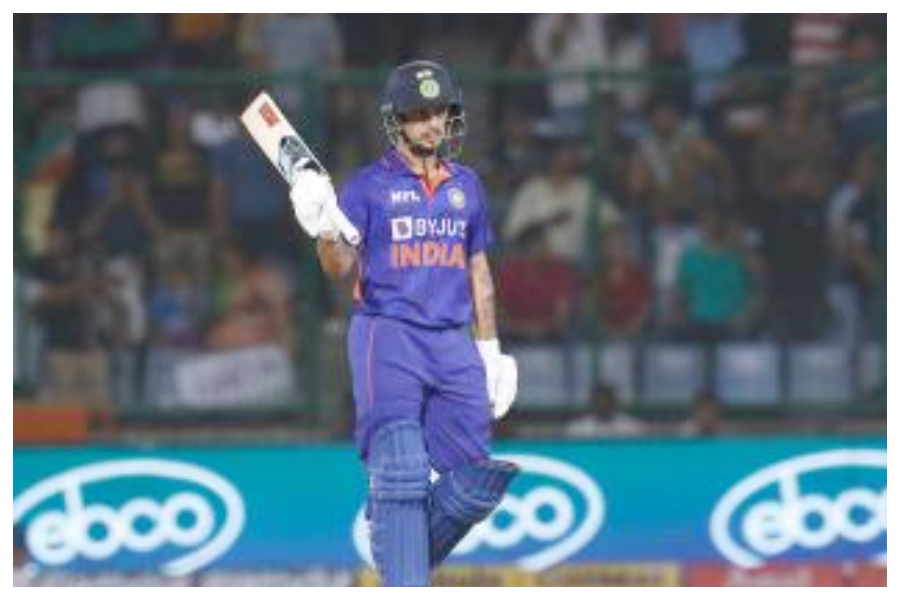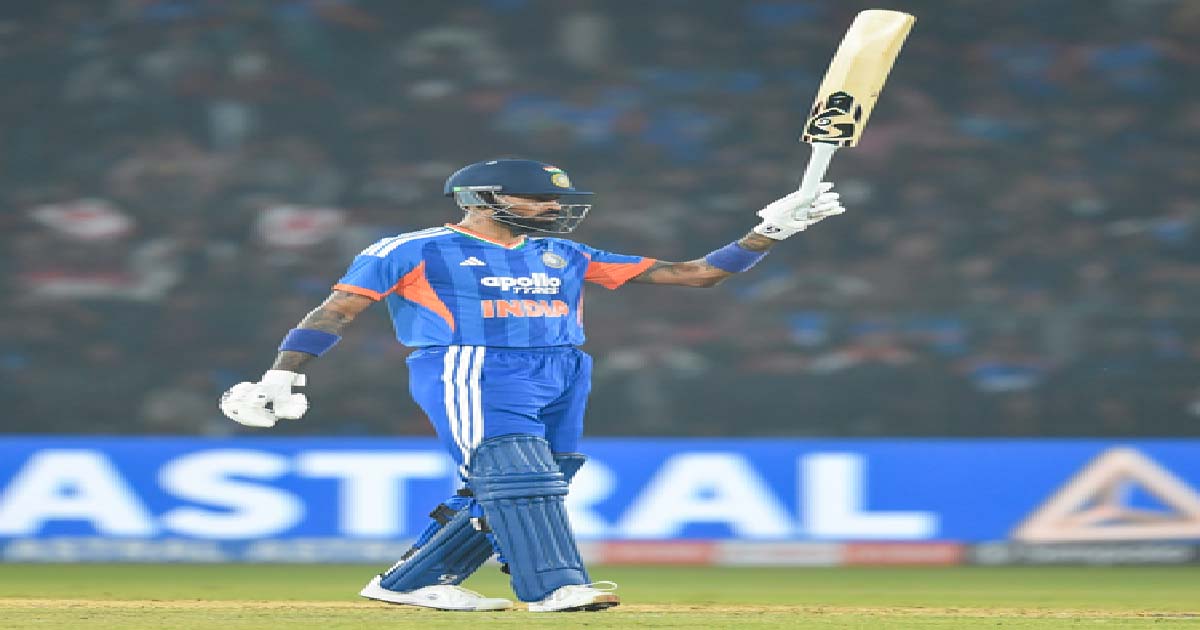Sports
IND v SA, 1st T20I: Ishan Kishan leads the way for India’s future batting template

Very rarely, one gets to pick positives from a loss in cricket. Despite India being handed a seven-wicket defeat by South Africa at the Arun Jaitley Stadium on Thursday, they had a big positive to pick — racking up 211/4 in their 20 overs, thanks to a super-aggressive approach with the bat, led by Ishan Kishan’s 76.
India’s approach with the bat was like an action sequence from a Hollywood flick — runs coming thick and fast, first coming through edges and then through scintillating stroke play.
None of the batters tried to play anchor; everyone yearned to be the aggressor and get the big hits, seen from the strike-rates of Kishan (158.33), Gaikwad (153.33), Pant (181.25) and Pandya (258.33), with Iyer’s strike-rate of 133 looking pale.
All five batters got their first boundary within the first 10 balls of the innings, clearly not in a mood to waste time at the crease.
It was in complete contrast to their outdated approach with the bat; one would anchor the innings and rest would play around him, a chief factor in their early exit from the Men’s T20 World Cup last year.
But, in New Delhi, Kishan, captain Rishabh Pant and vice-captain Hardik Pandya later on, showed how going from the word go, devoid of any fear or tension, can bring some phenomenal batting returns despite having a streaky start.
Kishan’s first boundary came when he was beaten in flight by Keshav Maharaj in the opening over, but the outer edge ran past short third man. Luck continued to be on India’s side as a neck-high bouncer from Anrich Nortje saw Ruturaj Gaikwad hook over fine-leg, with the top-edge coming into play.
Kishan and Gaikwad rode their incredibly good fortune through the rest of power-play, amassing 51 runs but never letting go of the aggressive approach despite being tested by some sharp seam movement from the pacers.
After Gaikwad fell to Wayne Parnell, Kishan struggled for fluency till the ninth over when Dwaine Pretorius arrived.
The first ball of the over, width on offer and Kishan played the late cut to get the boundary past fielder at point. When Pretorius tried to correct his length on the final ball, Kishan hammered it through cover to collect another boundary. It was just the over Kishan needed to break free and find his boundary-hitting groove, which reached its high point when Maharaj was re-introduced in the middle overs.
After reaching his fifty in 37 balls by slog-sweeping the left-arm spinner, Kishan unleashed carnage on Maharaj in the 13th over — two more sixes were dispatched to mid-wicket fence and were followed by two boundaries down the ground.
“Initially we knew that we cannot get going on this wicket. My plan was to target the loose balls. In T20Is, powerplay is very important. We need to respect good bowlers as Nortje and Rabada have done really well for their country. My plan was to keep playing my shots and make them change their line and length,” said Kishan about his knock of 76 in the press conference.
Though he holed out to long-on on the last ball of the over in trying to hit another six, Kishan had done his job of setting the base for Pant and Pandya to carry forward the big-hitting spree. He had support from the other end when Shreyas Iyer danced down the pitch thrice to dispatch Tabraiz Shamsi for three sixes towards the leg-side before slowing down and eventually being castled by Pretorius.
“When the left-arm spinner came onto bowl, I told Shreyas that I will take my chances and told him that he can attack when Shamsi was bowling, because you got to be smart at this level. We just planned and it went our way,” were Kishan’s words in the innings break on him and Iyer acing the match-up game against South Africa’s spinners.
Pant and Pandya, made captain and deputy respectively on the eve of the series opener, hit seven boundaries between themselves from overs 17 to 19 with some audacious shots to take India past 210-mark. The duo had spent their match eve effortlessly clearing the ‘V’ in a range-hitting practice and hence, it was no surprise to see them take Pretorius, Parnell and Rabada to the cleaners.
Only time will tell if what India did with the bat at New Delhi will kick-start a change in their approach to batting in the first innings, especially after the rested/injured stalwarts return. But, if one goes by the visuals of Thursday’s innings, they did make gains with the batting formula despite the result not being on their side.
Crime
One more accused arrested for vandalism during Lionel Messi’s Kolkata event

Kolkata, Dec 17: One more person has been arrested in connection with the vandalism during Lionel Messi’s event at Salt Lake Stadium on December 13, taking the number of those arrested to six, the Bidhannagar police said on Wednesday.
Meanwhile, a Special Investigation Team (SIT), formed by the West Bengal government on Tuesday, began its probe into the matter.
According to police sources, the sixth arrest was made late on Tuesday night. The arrested person has been identified as Rupak Mandal. Police sources said that the accused will be produced before the Bidhannagar Sub-Divisional Court and charged with vandalism, creating disorder and disrupting law and order at the Yuva Bharati Krirangan.
The sources also said that several other individuals are suspected of being involved in the incident, and they may also be interrogated, if necessary. It has also been hinted that the number of arrests may increase in the coming days based on the progress of the investigation, and once the examination of CCTV and other video footages are completed.
The sources stressed that they are investigating how the situation spiralled out of control on the day of the incident, who directly participated in the vandalism, and who instigated the violence from behind the scenes. It was learnt that investigators are separately analysing the role of each arrested accused.
Noting the seriousness of the incident and the questions raised about security arrangements at Yuva Bharati, one of the state’s most prominent sports stadiums, the state government has formed the SIT, which will focus on how the disorder spread at the Yuva Bharati Krirangan, where the security lapses occurred, and whether there was any negligence on the part of the responsible agencies or officials.
According to administrative sources, the SIT members visited the Yuva Bharati Krirangan on Wednesday. They are inspecting the site, assessing the extent of the vandalism, and the amount of damage. After reviewing the situation, they will prepare a detailed report on the security arrangements on the day of the incident.
Meanwhile, following this incident, the administration is considering strengthening security measures for future large-scale events at the Yuva Bharati Krirangan. It includes ensuring adequate police surveillance, increased security checks at entry points and the use of modern technology to control crowds.
On December 13, the Salt Lake Stadium was full long before Messi’s event began, with spectators waiting to see their favourite footballer.
As soon as Messi arrived, many people surrounded him, trying to take pictures. As Messi’s security guards were also there, a chaotic situation prevailed overall, and spectators complained that they couldn’t even see him.
Messi left the field within just 22 minutes. After that, vandalism began. Chairs and bottles were thrown onto the field from the stands. Many spectators broke down the gates and entered the field.
Vandalism occurred in the galleries and restrooms of the Yuva Bharati Krirangan. Following this incident, the state government formed an investigation committee. Event organiser Satadru Dutta was arrested. On Tuesday, Aroop Biswas resigned as state Sports Minister while top IPS officers, including DGP Rajeev Kumar, were issued a show-cause notice.
National News
Team India has benefited immensely from Hardik’s ability: Bangar

New Delhi, Dec 17: Former India batting coach Sanjay Bangar highlighted Hardik Pandya’s impact with bat and ball, stating that the Men in Blue have benefited massively because of the all-rounder’s abilities.
Pandya returned to competitive cricket earlier this month after missing out for over two months due to the injury he sustained during the Asia Cup semi-final in September. He made an immediate impact in the game for the Men in Blue and played a crucial role in the team’s successful outings against South Africa in the ongoing five-match T20I series.
Speaking to JioStar, Bangar lavished praise on Pandya, emphasising the Baroda cricketer’s unique batting mechanics and his value as a bowling option in T20 cricket, as he said, “Going deep inside the crease is Hardik Pandya’s speciality.
Even when he goes that deep, his weight remains on the front foot, which is a very good thing. As a batter, we always encourage waiting for the ball. He plays with a very wide base, which allows him to generate a lot of power.”
“He can play front-foot shots, back-foot shots, baseball-style hits, full shots and the upper cut. He opens up both sides of the ground, which is a special ability. He bowls at around 132–133 kmph with a fuller length, where close to 54 per cent of his deliveries are pitched up, and he gets wickets from there. He allows the ball to swing, and when required, he goes for the yorker as well. The Indian team has benefited immensely from his ability,” he added.
Bangar highlighted Abhishek Sharma’s fearless approach, underscoring the technical elements that enable the young batter to dominate bowlers. Opining on his attacking mindset, Bangar stated, “First of all, it’s his attacking mindset. If there’s a delivery outside the off stump, he hits it very hard. One very important aspect of his batting is his high backlift. He holds the bat above the handle, which gives him excellent reach. Because of the swing he generates, he can hit big sixes, especially over the covers. Hitting sixes over the covers is a special ability. He doesn’t try to hit from below, which gives him an incredible range.”
Turning his attention to Shubman Gill, Bangar acknowledged the Indian opener’s form while pointing out specific areas that need refinement, particularly against straight deliveries.
“In the beginning, his footwork was very positive. But if you remove three or four boundaries over 28 games, the issue has been on straighter lines. Against straight deliveries, his strike rate has fallen quite low. Outside the off stump, his strike rate is good, but there have been a few edges as well.
Overall, he has scored runs, but straight-line play is something he will want to improve. In the second game, the ball that got him out was a very good delivery—it could have dismissed any batter. His footwork has improved, and if he continues to play with clear footwork, he will be able to hit the same shots consistently, like the three or four boundaries we’ve seen,” he noted.
While India have enjoyed the upper hand in the series so far, Bangar cautioned against underestimating South Africa, particularly with the conditions on offer in Lucknow, saying, “The way this series has gone, South Africa has fought well in every format. On the Lucknow pitch, there is bounce and seam, and South Africa’s fast bowlers will look to make early inroads. India will need to be prepared for that challenge.”
With India holding a 2–1 advantage in the five-match T20I series against South Africa, the spotlight now turns to Lucknow for the fourth game, as the two sides gear up to face off at the Bharat Ratna Shri Atal Bihari Vajpayee Ekana Cricket Stadium on Wednesday.
National News
Mamata Banerjee announces judicial committee to probe chaos at Salt Lake Stadium over Lionel Messi’s visit

Kolkata, Dec 13: With chaos and vandalism breaking out at Salt Lake Stadium on the northern outskirts of Kolkata on Saturday over high ticket prices and limited access to Argentinian soccer star Lionel Messi during his visit to the stadium, West Bengal Chief Minister Mamata Banerjee announced setting up a judicial committee headed by a retired judge of the Calcutta High Court to probe the mismanagement that led to the chaos.
With the agitators resorting to a rampage within the stadium over limited access to Messi despite purchasing tickets at exorbitant prices, the police had to resort to a massive lathi charge and deploy Rapid Action Force (RAF), following which the Argentinian soccer star left the stadium early.
The Chief Minister was on her way to the stadium. However, on receiving the news of the ruckus at the stadium, she directed her driver to turn back the car. Soon after that, she issued a statement announcing her decision to set up a judicial committee headed by a retired judge of the Calcutta High Court to probe the mismanagement that led to the chaos.
“I am deeply disturbed and shocked by the mismanagement witnessed today at Salt Lake Stadium. I was on my way to the stadium to attend the event along with thousands of sports lovers and fans who had gathered to catch a glimpse of their favourite footballer, Lionel Messi. I sincerely apologise to Lionel Messi, as well as to all sports lovers and his fans, for the unfortunate incident,” the Chief Minister said in her social media statement.
Announcing the decision to form the judicial probe committee, she said that the committee will be headed by Justice (Retd) Ashim Kumar Ray. The state chief secretary, Manoj Pant, and the additional secretary to the state home and hill affairs department, Nandini Chakraborty, will be the two other members of the probe panel.
“The committee will conduct a detailed enquiry into the incident, fix responsibility, and recommend measures to prevent such occurrences in the future. Once again, I extend my heartfelt apologies to all sports lovers, the Chief Minister added.
-

 Crime3 years ago
Crime3 years agoClass 10 student jumps to death in Jaipur
-

 Maharashtra1 year ago
Maharashtra1 year agoMumbai Local Train Update: Central Railway’s New Timetable Comes Into Effect; Check Full List Of Revised Timings & Stations
-

 Maharashtra1 year ago
Maharashtra1 year agoMumbai To Go Toll-Free Tonight! Maharashtra Govt Announces Complete Toll Waiver For Light Motor Vehicles At All 5 Entry Points Of City
-

 Maharashtra1 year ago
Maharashtra1 year agoFalse photo of Imtiaz Jaleel’s rally, exposing the fooling conspiracy
-

 National News1 year ago
National News1 year agoMinistry of Railways rolls out Special Drive 4.0 with focus on digitisation, cleanliness, inclusiveness and grievance redressal
-

 Maharashtra1 year ago
Maharashtra1 year agoMaharashtra Elections 2024: Mumbai Metro & BEST Services Extended Till Midnight On Voting Day
-

 National News1 year ago
National News1 year agoJ&K: 4 Jawans Killed, 28 Injured After Bus Carrying BSF Personnel For Poll Duty Falls Into Gorge In Budgam; Terrifying Visuals Surface
-

 Crime1 year ago
Crime1 year agoBaba Siddique Murder: Mumbai Police Unable To Get Lawrence Bishnoi Custody Due To Home Ministry Order, Says Report






















